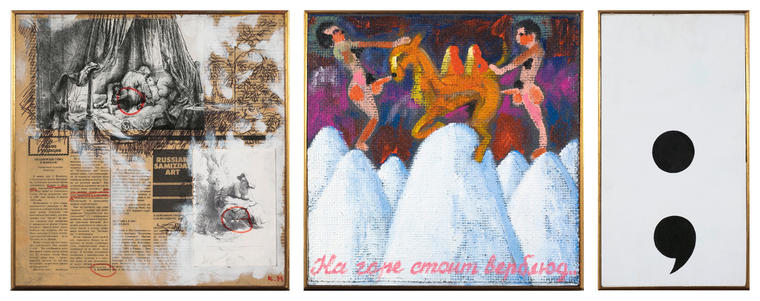
Vitaly Komar and Alexander Melamid have been an artistic tandem for over thirty years. Having graduated from the Stroganov School in 1967, they continued to be friends and work together. In 1972, while working on the design of one of the children's camps for the 50th anniversary of the pioneer organisation, in the cold winter, for a glass of vodka, Komar and Melamid invented social art (an analog of pop art, but on a specific, Soviet basis). Hating themselves for agreeing to this "hack-work" and now compelled to draw "propaganda muck" (posters, slogans, Lenin's profiles, images of the heroes of socialism), they suddenly realised that one can look at the incredible overproduction of the ideology reigning around from another angle: "Could there be some artists who would do this for the soul? What could be his work? ". Thus, an imaginary "character" was born who would "write slogans as a personal cry of the soul. The official would become personal". And then the young people realised that this was not even a separate person, but an entire course. In the same year, the Manifesto of Sots Art appeared, which, among other things, read: "... Social art is not related to the concepts of beauty and aesthetic experience. A picture is not important, but a conversation about it. What is important is not a pictorial reception, but a clash of styles and the expected reaction to this clash ... Sots Art is the disclosure of the eclecticism and ambivalence of the minds of our contemporaries ... ". A new analysis not only of everyday everyday life (socialist reality), but of the artistic language of that time, led the social art to the ironic interpretation of the main enemy of nonconformists-socialist realism. As a result, the concept turned out to be so radical that it was not only "offended" by official art, but it was not immediately accepted by the unofficial art. And Komar and Melamid, meanwhile, also developed the idea of co-authorship, which was unconditionally followed until the end of their joint work in 2003. Since 1972, they have signed their works with two names. After all from 1978, both artists live in New York and are still in high demand.
Polyptych "Happy New Year" was created as part of the "Diaries" series, these are five canvases held together, five different themes. Each part is created in different style and with a different plot, not related to the neighboring one. The picture reproduces the consciousness of modern man: a huge number of events in life flashes with furious speed, and we fix only some of them. Also, these "frames" resemble the change of programs in the TV. From the abstraction, similar to the pattern of a kaleidoscope, and a realistic depiction of the mysterious execution in the apartment against the backdrop of the TV, to the joyful New Year postcard in the style of pop art and gloomy surrealism in the manner of René Magritte. Artists themselves explain that this is a conceptual eclectic, which was mentioned in the 1972 Manifesto of Sots Art, "a peaceful mixture of right and wrong". Vitaly Komar comments on this work as very attuned. Ideally, since these are pages from the diary, the artists had to write them daily, but, of course, strayed from the schedule. Multi-genres and difference of painting is explained, among other things, by the attitude of the authors themselves at the particular moment of creating this or that part of the picture. "If, for example, I am a hangover, I can work in an expressionistic spirit, and if I'm in a calm analytical mood, it's better to draw in a realistic style. That is, the style is a reflection of our state, intonation", – says Vitaly Komar.
The series "Diaries" appeared in 1984-1985, at the height of the "return of painting" in America and Europe. So Komar and Melamid were again "on the crest of the wave", not even adjusting to the new trends of the 1980s. They continued to do what they started back in the 1970s, and quite successfully. In 1985, the year of the appearance of the presented work, the artists held an exhibition in the Louvre of Paris.
"Diaries" consist of a series of polyptychs, parts of which are collected in intricate compositions. They, like our life, are diverse to complete confrontation with each other. This postmodern works, citing and playing not only a variety of styles and genres, but also themselves. Works in which, as American critic Carter Ratcliffe wrote, "images taken out of context, disfigured by irony, distorted by nostalgia, images reinvent each other's values in an intimate process rich in feelings and motivations". V





